Making changes to your home can be A daunting task, Especially when it comes to deciding on the perfect flooring for your dining room. Finding just the right look and design for A dining room floor can be overwhelming with all of the available options. This article will provide helpful information about some of the best dining room floor ideas that will match any style or budget. In this article we inform you of dining room floors ideas, There are some easy guides for doing that job. So let’s go to the article.
What Type Of Flooring Is Best?

The best type of flooring for A dining room depends on the style and atmosphere you want to create. Hardwood flooring is A classic option that adds warmth and beauty to the space. While tile or stone floors offer A more modern look. Carpet can also be an option if you’re looking for something softer and quieter underfoot.
When deciding which type of flooring is best for your dining, Consider how much maintenance it requires. Hardwood floors need regular refinishing and waxing, while tile or stone may require occasional resealing. The carpet can be vacuumed regularly but will need A professional cleaning every few years.
Finally, Consider the cost of each option when making your decision. Hardwood flooring tends to be more expensive than other types of flooring, While carpet may be less expensive but require more frequent replacement in high-traffic areas like the room.
How To Choose The Right Dining Room Flooring?

When it comes to choosing the right flooring for your dining room, There are A few key factors to consider. First, Think about how much foot traffic your room will receive. If you have A large family or often entertain guests. You’ll want to choose durable materials like hardwood or tile that can stand up to wear and tear. Next, Consider the style of your home and the overall look you want to achieve in the space. Natural materials such as wood and stone provide A classic look. While vinyl is an affordable option that comes in many colors and patterns. Finally, Factor in the ease of cleaning. If spills are likely in your dining room, Opt for A surface that won’t be difficult to clean up. With these considerations in mind, You’ll be sure to find the perfect flooring for your dining room.
Importance Of Choosing The Right Dining Room Table Floor

Choosing the right dining room table floor is an important decision that can have a big impact on your space. Not only does it affect the look and feel of the room. But it also affects how comfortable you and your guests will be when using the table.
When choosing A dining table floor, There are several factors to consider. First, Think about what type of material you want for your flooring. Hardwood floors are timeless and classic, While tile or laminate can be more affordable and easier to maintain. Consider how much foot traffic the area will get and how easy it is to clean as well.
Finally, Think about how the floor will fit in with the overall design of your space. Try to choose A color or pattern that complements your furniture and other elements in the room. By taking all these factors into consideration, You’ll be able to find A floor that looks great and works well with your dining room table.
Factors To Consider When Choosing Dining Room Flooring

When it comes to choosing the best flooring for A dining room, There are several things to consider. Homeowners should think about both aesthetic appeal and functionality when selecting dining room floors. Not only should the material chosen be able to withstand spills. But it should also complement the overall style of the room.
Durability is one of the most important factors when selecting dining floors. Hardwood is A popular choice for many homeowners because not only does it look great. But it can also take on A lot of wear and tear without showing signs of damage. In addition to hardwood, Ceramic tiles are another option that is highly resistant to spills and scratches. While providing an attractive finish with many design options.
Lifestyle And Family Needs
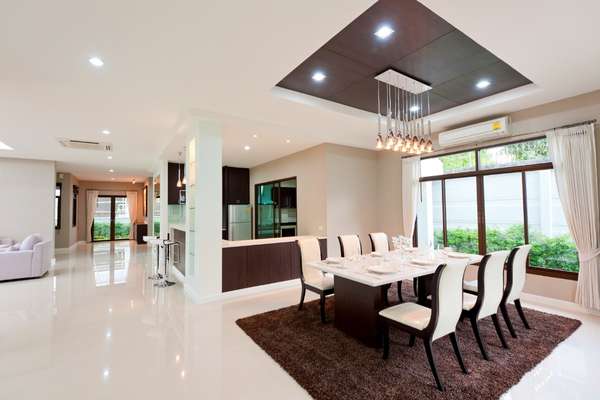
When making decisions about the decor for any room in your home, there are several factors to consider. One of the most important details is choosing the right flooring for each space. This is especially true when deciding on a dining room floor since this area will be used frequently and must remain attractive and durable over time.
The first factor to consider when choosing a dining floor is the lifestyle of your family. For example, if you have small children or pets that make messes, you may want to opt for harder surfaces like tile or hardwood floors that can easily be cleaned up with damp cloths. On the other hand, if you tend to entertain guests often and need something more comfortable underfoot than tile or wood. An area rug could provide both insulation from noise as well as added style points.
Aesthetics And Design Preferences

Aesthetics and design preferences are fundamental factors to consider when choosing a floor for your dining room. The style, color, material, and pattern of the floor can either make or break the entire look of the room. Homeowners should take into account both their own personal preference as well as their budget when selecting a suitable dining floor.
The size of the space is an important factor to consider when deciding on a flooring option. If you have open-plan living then large format tiles may be ideal; however, if you have smaller spaces that require more delicate detailing, porcelain tiles with intricate patterns may be best suited. Furthermore, it is also important to pick materials that will stand up to wear and tear if you frequently host guests in your home.
Durability And Maintenance Requirements

Durability and maintenance requirements should be at the top of your list. It’s important to take into account how often you plan on using the space, as well as any potential damage that could occur from spills or heavy furniture movement. The right material can ensure that your floor looks beautiful for years to come with minimal effort required in upkeep and repair.
Wood is a popular choice for dining room floors. But it requires regular cleaning to maintain its luster and protect against scratches and scuffs. Laminate is also an option, but it may not stand up to the wear and tear of frequent use in a high-traffic area. Other materials such as ceramic tile or even concrete can provide superior durability if properly sealed against water damage.
Budget And Installation Costs
It is important to consider the budget and installation costs associated with the project. Homeowners should take into account the size of the room, the materials chosen, and the type of installation when formulating their budget. Different kinds of flooring will have different levels of cost as well as the amount of time needed for installation. Laminate flooring can often be installed quickly and provides a more affordable option than hardwood or tile.
Prior to purchasing flooring, homeowners should research the installers in their area to get an idea of what labor costs might look like. It may be beneficial to obtain multiple estimates. So that they can compare prices and determine which installer is right for them. Additionally, it is important to factor in any additional payments such as sales tax or delivery charges that may increase the total cost of the project.
Here Are 12 Best Dining Room Floors Ideas
1. Hardwood Floors

Hardwood floors are a classic and timeless look for any dining room. They offer a sleek, sophisticated appearance that is sure to make an impression. Their natural beauty complements many different design ideas and can be used to create both modern and traditional looks. Depending on the specific style of wood chosen and the installation methods used.
When it comes to flooring ideas for dining rooms, hardwood cannot be overlooked. This type of flooring is highly durable, easy to maintain over time, and adds a touch of luxury wherever it’s installed. Hardwood floors come in a wide variety of color options, so you can choose one that best suits your taste and décor preferences. Additionally, hardwood floors can add value to your home if you ever decide to sell them down the line.
Advantages Of Hardwood Floors
Hardwood floors are a timeless and classic choice for dining floors. Not only are they aesthetically pleasing, but they come with many practical benefits as well.
For homeowners looking to create an inviting and warm atmosphere in their dining rooms, hardwood floors offer an attractive solution. Hardwood flooring is easy to clean and maintain – spills can be wiped up quickly and debris can be vacuumed or swept away with ease. The natural beauty of the wood adds a touch of elegance that complements any style of décor. Additionally, hardwood floors also offer superior durability – they’re designed to last for decades with proper care and maintenance. They resist damage from heat, moisture, foot traffic, furniture legs, pet claws – you name it! And since their finish is naturally resistant to stains and fading, these floors will look like new for years to come.
Disadvantages Of Hardwood Floors
Hardwood Floors have been a popular choice for many homeowners when it comes to decorating their dining rooms. While these floors can provide an aesthetically pleasing look and feel, they are not without some drawbacks.
First, hardwood flooring is susceptible to damage by moisture or spills. It has high traffic or often hosts large gatherings, there is always a risk of liquid spills that could ruin the wooden flooring. Additionally, hardwood floors are more difficult to clean than other types of flooring such as tile or laminate due to their porous nature and the need for special cleaning solutions designed specifically for wood surfaces.
Furthermore, hardwood floors require regular maintenance such as sweeping and polishing in order to keep them looking attractive and smooth.
Maintenance Tips For Hardwood Floors
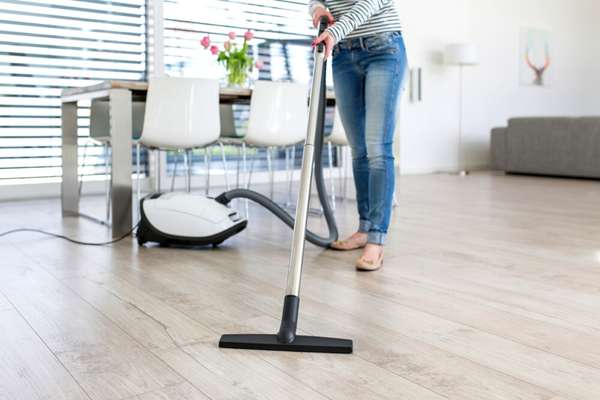
Maintaining hardwood floors is essential to protect their beauty and resilience. The right maintenance tips can help homeowners care for their hardwood floors in the best way possible. Knowing the basics of cleaning and caring for your hardwood flooring can ensure that it will last for years to come.
Regular sweeping and vacuuming with a soft-bristled brush attachment can help remove dust, dirt, pet hair, and other debris from the surface of your hardwood floors without scratching them. Use an approved wood cleaner to avoid damaging any coating or sealant on the flooring; this will also help preserve its natural shine. When using a wet mop or cloth, be sure to wring out as much water as possible before applying it; excess moisture can cause damage over time and create warping or buckling in certain areas of your floor.
2. Tile Floors
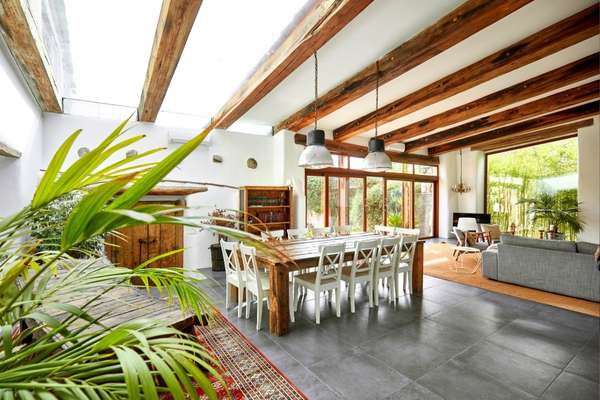
Tile floors are a popular choice among homeowners for dining room floor ideas. Not only are they durable, but they’re also stylish and easy to maintain—making them an attractive option for dining areas. Tiles come in various shapes, sizes, colors, textures, and materials; which makes it possible to create a unique look that fits your home’s décor and design.
When selecting tile flooring for your dining it’s important to consider both form and function. Glazed ceramic tiles are a great option as their non-porous surface is easy to clean up spills or food messes while still providing style. Natural stone tiles can also be used; however proper sealing should be done regularly in order to protect the stone from staining or etching from acidic foods like citrus fruits or tomatoes.
Advantages Of Tile Floors
Tile floors are a great choice for dining rooms due to their durability and easy maintenance. Tile is much more resistant to scratches, stains, and wear and tear than other flooring materials such as carpet or hardwood, making it an ideal material for a room that gets frequent traffic. Additionally, tile is very easy to clean and maintain; spills can be wiped up quickly with a damp cloth, and the surface can be mopped periodically to keep it looking fresh.
Tile also offers many aesthetic advantages in a dining set. It comes in a variety of colors and textures, allowing you to customize the look of your space. You can also choose from different sizes and shapes of tiles to create unique patterns on the floor that will add visual interest to the room.
Overall, tile floors provide many practical benefits in dining rooms due to their durability and low maintenance requirements.
Different Types Of Tile Options Are Available

Tile is an excellent choice when it comes to flooring. There are many different types of tile options available that can suit any budget and design style. Porcelain, ceramic, natural stone, quarry, cork, and vinyl tiles each have unique characteristics and benefits that make them suitable for a variety of flooring applications. From durability to water resistance to maintenance requirements, there is a tile option for everyone.
Pros And Cons Of Different Tile Materials
Tile is a versatile and durable material that can be used in a variety of applications. However, different tile materials come with their own pros and cons. Ceramic tiles are easy to clean and provide a timeless look, but they can be slippery when wet and prone to cracking if installed on an uneven surface. Porcelain tile is highly stain-resistant and strong enough for both indoor and outdoor use, but it can chip easily if not properly maintained. Natural stone tiles are eye-catching and add character to any space, but they require more maintenance than other materials due to their porous nature. No matter what tile material you choose, it is important to consider all the associated pros and cons before making a purchase.
3. Laminate Floors
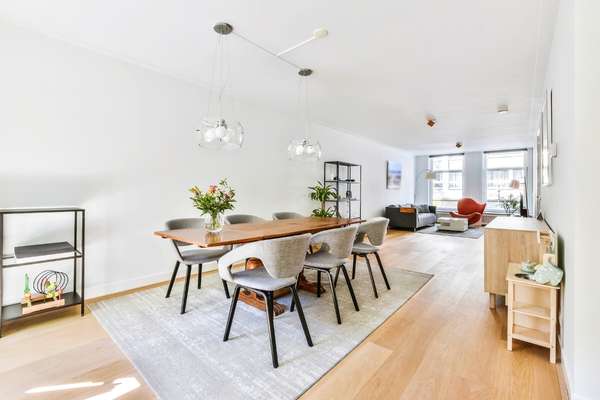
Laminate floors are the perfect addition to any dining room. They offer an easy-to-maintain surface that resists scratches, dents, and stains. As a DIY project, laminate floors can be installed with minimal effort, making them a great option for those looking for cost-effective flooring solutions.
For those who want to make their dining room stand out from the crowd, laminate floors come in a range of colors and finishes. Whether you’re looking for something modern or classic, there’s sure to be a style that fits your home décor. Laminate floors also feature realistic wood grain patterns that give any space an added touch of elegance. Plus, they can often be installed over existing flooring – no need to tear up old carpets or tiles!
Advantages Of Laminate Floors

Laminate flooring is an excellent choice for dining rooms due to its durability and affordability. Laminate floors are made from layers of composite materials that are sealed together with a protective layer, making them resistant to scratches and stains. This makes them ideal for dining rooms since they can handle the daily wear and tear of foot traffic and spills. Additionally, laminate floors come in a wide variety of colors and styles, allowing you to customize the look of your dining without breaking the bank. Finally, laminate floors are easy to install and maintain, making them an attractive option for those looking to upgrade their dining quickly and easily.
Styles And Patterns Available For Laminate Floors
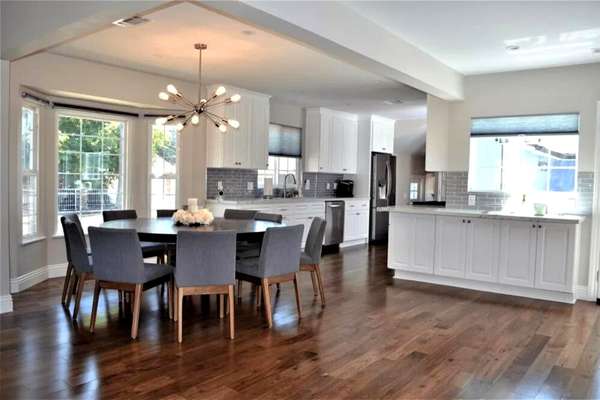
When it comes to home flooring, laminate is a popular choice for many homeowners. Laminate floors are known for their durability, affordability, and a wide array of style options. There are numerous patterns and styles available that can easily coordinate with any dining room décor.
For those looking to enhance their dining. There are several types of laminate flooring to choose from. As hardwood replicas with knotty grain textures or smooth finishes in hickory or oak. For a classic look, luxury vinyl planks can also be used. They boast elegant stone-like visuals with realistic grouting lines that help create the perfect setting for entertaining guests in style. To truly make your dining room stand out, opt for bolder designs like wood parquet. Tiles in contrasting colors like cherry and teak for an eye-catching effect.
Maintenance Tips For Laminate Floors

It’s no surprise that laminate flooring is a popular choice for dining room floors. Not only does it provide an aesthetically pleasing, modern look, but it also offers easy maintenance and cleaning capabilities. To keep your laminate floors looking luxurious for years to come.
Start by vacuuming or sweeping the surface of the floor regularly with a soft brush attachment to remove dirt and debris. Additionally, you can use a mop or damp cloth to clean spills as soon as they occur; if not, residue will form on the surface which can be difficult to remove without damaging the finish. Make sure you avoid using any harsh cleaners or abrasive scrubbing pads when mopping the floors.
4. Carpeted Floors

Carpeted floors in the dining room are an excellent idea for those looking for a warm, inviting atmosphere. Not only do carpets provide insulation from sound and cold temperatures, but they also add visual texture to the space. If you’re wondering what kind of carpet will work best in your dining room. There are a few ideas that may be of interest.
One option is choosing a low-pile carpet with neutral tones. This will create a classic look without overwhelming the space and allow other elements within the dining to stand out as well. Its tight weave adds structure while its understated color palette allows it to blend into any existing decor style. On top of this, its low-pile nature makes it highly durable and easy to clean—perfect for high-traffic areas such as those found around dining tables!
Advantages Of Carpeted Floors
Carpeted floors offer homeowners many advantages in their dining rooms, making them a popular choice for flooring. Carpeted floors provide a sound barrier between the dining and other parts of the house. Helping to muffle loud noises from activities like entertaining guests or children running around. Carpet also provides warmth underfoot, especially during the cooler months. Making it an ideal choice for those looking for an extra layer of comfort when spending.
A carpet is also a great option for those who are concerned about safety as it helps to cushion falls, which can be especially beneficial if there are small children in the house who may not yet be familiar with how to safely navigate furniture and other objects in the room.
Different Styles And Patterns Available
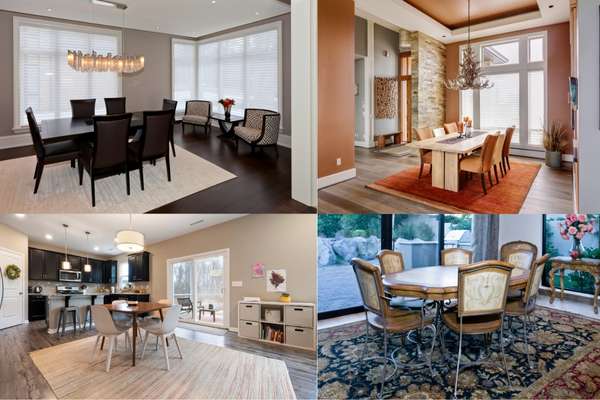
When it comes to carpeted flooring, there are many styles and patterns to choose from. Homeowners can select from plush carpets for a luxurious look and feel, or Berber carpets for more of a casual look. Each type of carpet provides unique benefits, from enhanced cushioning to increased durability.
There are also numerous color options available in both cut pile and loop pile carpets. Both varieties offer an array of textures, ranging from soft and velvety to tough and rugged. Homeowners can choose solid colors or intricate patterns that add character and personality to any room in the house. Additionally, patterned carpets provide the ability to easily match furniture pieces that may have bolder colors or designs.
Maintenance Tips For Carpeted Floors

Carpeted floors can be an attractive and comfortable addition to any home. However, they require maintenance and care to keep them looking their best. Properly caring for your carpeted floors is essential to ensuring that they maintain their beauty for many years to come. With these simple maintenance tips, you can make sure that your carpeted floors stay in great condition.
First, vacuum regularly with a powerful vacuum cleaner equipped with a rotating brush head. Regular vacuuming can help remove dirt, dust, and other particles from carpets before they become embedded deep within the fibers of the carpeting. Vacuuming also helps prevent long-term damage caused by wear and tear on the fibers of the carpeting over time. It’s important to move furniture away from walls when vacuuming so that all areas of the floor are cleaned thoroughly.
5. Concrete Floors

Concrete floors are becoming increasingly popular in modern dining room design. They bring a unique and contemporary aesthetic, while also providing durability and low maintenance. With the right combination of creative ideas and resources, you can create an attractive and stylish space with concrete floors.
For a sleek look, consider staining the concrete to achieve a glossy finish or adding texture with exposed aggregate. You could also dress up the area by framing it with tile or wood edging for a more rustic style. If you’re looking to add color to the space, you can choose from a variety of dye options available for concrete materials. To maximize comfort underfoot, consider investing in floor heating systems to keep your feet warm during cooler evenings.
Choose unique light fixtures such as pendant lights or chandeliers for added interest in your dining room design project.
Pros And Cons Of Concrete Floors
If you’re considering remodeling your dining and are looking for a unique flooring option, concrete floors may be a perfect choice. Though not traditionally found in many dining rooms, concrete floors offer a modern look and can be surprisingly affordable. Before making any decisions on your new flooring, it is important to consider both the pros and cons of having concrete floors.
One major benefit of having a concrete floor in this space is that they require little maintenance. Unlike wood or tile, there’s no need to worry about waxing or sealing. The surface regularly; just an occasional sweeping or mopping with mild detergent will do the trick. Additionally, because they are extremely durable and stain-resistant, spills from food and drinks will not cause permanent damage to the surface of the floor.
Maintenance Tips For Concrete Floors

Maintaining concrete floors can seem like a daunting task, but with proper care and maintenance, your concrete floor will look great for years to come.
First, it’s important to clean the floor regularly with mild soap or detergent and warm water. This will help prevent dirt from accumulating on the surface of the floor and also make it easier to clean later on. Additionally, applying a sealer or wax every year is important in order to protect the surface of the floor against stains and abrasions. When mopping or sweeping the floor, be sure to use an appropriate cleaner that won’t damage the finish of your concrete floors.
Finally, if you notice any cracks in your concrete floors it’s important to address them as soon as possible.
6. Vinyl Floors
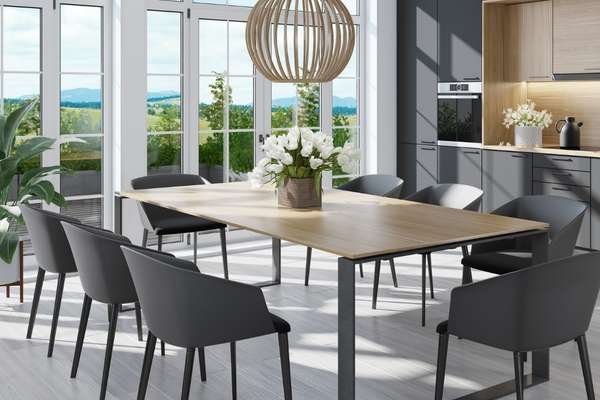
When it comes to choosing the perfect flooring for your dining, vinyl floors could be a perfect choice. Vinyl is a great option for those who want to add style and sophistication to their home without breaking the bank. Not only do vinyl floors look beautiful and stylish, but they are also very durable and can withstand heavy foot traffic as well as spills.
Vinyl floors come in a variety of colors, patterns, and textures so you can easily find one that matches the rest of your home decor. You can even customize your vinyl flooring by adding different features such as customized borders or inlays that will make your dining room stand out from the rest. Vinyl floors are also easy to install which makes them an excellent choice for anyone looking for an easy way to update their dining room without having to hire a professional installer.
Pros And Cons Of Vinyl Floors
Vinyl floors are a great option when determining the perfect flooring for your dining. Not only do they come in a variety of styles and colors, but they’re also extremely easy to install and maintain. However, there are some drawbacks as well that need to be taken into consideration before making the final decision.
The main advantage to installing vinyl floors is its affordability; it’s one of the most cost-effective materials you can choose. Additionally, it is resistant to water damage and staining, so spills should not be an issue if you have young children that often eat at the table. Vinyl floors are also very durable; they will last much longer than many other types of flooring available on the market today.
Maintenance Tips For Vinyl Floors
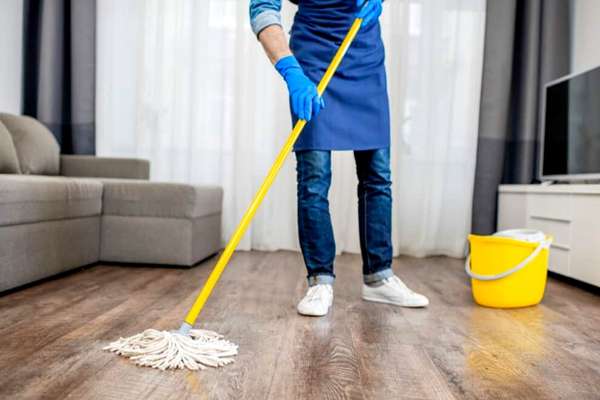
Vinyl floors are a popular choice among homeowners due to their durability, affordability, and easy maintenance. However, taking the proper steps in maintaining your vinyl floors can ensure they stay looking pristine for years to come.
First, make sure that you address any spills immediately by wiping them up with a cloth or sponge and soapy water. Vinyl is waterproof but allowing liquids to sit on the surface of the flooring can cause staining or discoloration over time. Additionally, using a vacuum or dust mop regularly on your vinyl floors will help reduce dirt build-up which can lead to scratching. If deeper cleaning is required, use an appropriate cleaning solution specifically designed for vinyl floors and avoid harsh chemicals as this could damage the surface of your flooring.
7. Natural Stone Floors
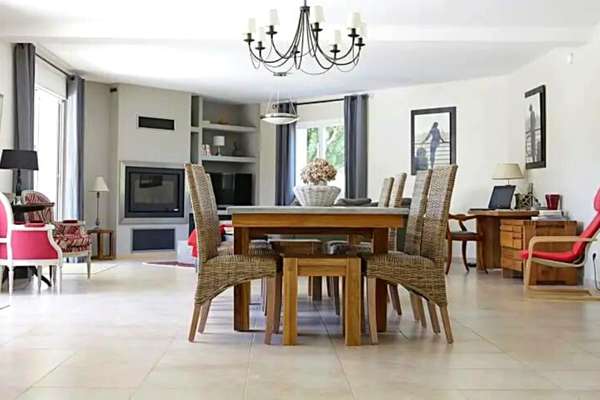
Are you looking for ideas to makeover your dining room floors? Natural stone might be the perfect option! Natural stone flooring can add character and charm to any space while also providing a long-lasting, durable foundation. From marble slabs to slate tiles, natural stone is available in a wide variety of textures and colors so that you can find just the right look for your home.
The advantages of natural stone flooring go beyond its aesthetic appeal. It is strong enough to withstand heavy foot traffic over many years without noticeable wear and tear; it adds value to your property; and it isn’t prone to scuff marks or scratches like some other types of flooring. Additionally, natural stones are resistant to water damage, making them ideal for humid climates or rooms with frequent spills and splashes.
Pros And Cons Of Natural Stone Floors
With their timeless beauty and unique appeal, natural stone floors are a popular choice for many dining rooms. Natural stone offers the advantage of being naturally strong and durable, allowing it to stand up to heavy foot traffic in your dining area.
First and foremost, natural stone is often expensive compared to other flooring options such as tile or laminate. This high cost should be carefully weighed against the potential benefits of choosing this type of flooring in your dining. Additionally, regular maintenance is necessary with natural stone floors to keep them looking their best; this can include professional cleaning services as well as periodic sealing or waxing treatments.
Maintenance Tips For Natural Stone Floors
Maintaining natural stone floors can be a challenge, but with the right tips and guidelines, you can keep them looking beautiful for years to come. Natural stone is an excellent choice for flooring due to its durability, classic look, and wide range of styles. Following these simple maintenance tips will help ensure your natural stone floors remain in excellent condition.
First and foremost, it’s important to regularly sweep or vacuum your natural stone floors to remove any loose dirt or debris that can scratch the surface over time. To avoid damage from scrapes and scratches, use felt pads on furniture legs and cover high-traffic areas with rugs or runners. You should also clean spills as soon as possible using a damp cloth never scrub the area since this could cause further damage by dislodging the grout or sealant protecting the flooring material.
8. Wooden Floors

Wooden floors have been a popular choice for homeowners for many years, due to their natural aesthetic and durability. However, with the introduction of stone flooring, homeowners now have another option to consider when making their decision. Stone floors are a luxurious and stylish alternative that provides timeless elegance and sophistication.
With its luxe look, natural stone flooring is an ideal choice for those wanting to add extra sophistication to their home design. Natural stone floors come in a range of styles and colors which can be tailored to fit any style of home. The natural shine will reflect light and create an inviting atmosphere. As well as offering beauty, stone flooring is also incredibly durable, and able to last for many years without requiring much maintenance or attention. This makes it perfect for busy households with kids or pets running around!
Pros And Cons Of Wooden Floors
Wooden flooring can be an attractive and durable option for any dining. But potential buyers should weigh the pros and cons before making their selection.
On the plus side, wood is a natural material that adds warmth and texture to a room. It’s also highly durable, with some types of hardwood able to last for decades when maintained properly. In addition, wooden floors are relatively easy to clean compared to carpets or tile; simply sweep or mop as needed, then polish periodically for extra shine.
However, there are some drawbacks associated with wooden floors in dining. For instance, they tend to be more expensive than other flooring materials such as laminate or vinyl. Additionally, wood is susceptible to scratches and scuffs from furniture legs. That may need frequent polishing or repair if not taken care of properly.
Maintenance Tips For Wooden Floors

Wooden floors are a popular choice for many homeowners due to their attractive aesthetic and durability. To keep them looking beautiful, it is important to follow regular maintenance tips. Doing so can help prevent scratches, fading, and other damage that can occur over time.
To begin with, vacuum or sweep wooden floors at least once a week to remove dirt and dust. Be sure to use the right attachments–a broom with soft bristles is best. Never drag furniture or any other heavy objects across the floor as this can cause scratches. Additionally, protect wooden floors from exposure to direct sunlight by using window treatments like blinds or curtains. As UV rays can cause discoloration of the wood over time.
9. Black Ceramic Dining Floors

Creating the perfect dining room is a great way to make a house feel like home. Black ceramic floors are an excellent option for updating any dining room. Not only do they look chic and modern, but black ceramic floors are also incredibly durable and easy to maintain.
When it comes to choosing the right flooring for your dining. There are several factors that should be taken into consideration. Black ceramic tiles provide a sleek and elegant aesthetic that can easily be paired with any furniture or décor. They also offer incredible durability compared to other flooring materials and require minimal maintenance over time. Making them ideal for homes with children or pets. Plus, they can be easily cleaned using mild soap and water or a specialized cleaning solution specifically designed for use on ceramic surfaces. This makes them an ideal choice for busy households. That needs something that looks great but is low maintenance as well.
10. Ash Color Floors

If you are looking for a unique and sophisticated look for your dining. Ash-colored floors are a great way to get the job done. These light-colored wood floors can easily blend in with the rest of your décor and will create an inviting atmosphere for entertaining guests. Ash color is also extremely versatile, so it can be used in any style of home from traditional to modern.
For those who want a natural look, the ash color is perfect because it looks almost like white or gray. But has subtle hints of yellow or brown mixed in. It’s especially great for brightening up darker rooms that need some extra lighting up.
11. White Color Floors

If you are considering a change in your dining room, white color floors can be the perfect solution. These floors are simple and elegant, creating an atmosphere of sophistication within the room. White color is a classic choice for home décor, but if done correctly it can also create a modern edge.
When deciding on flooring ideas, white color is a versatile option to consider. It works well with all types of dining furniture and accents that range from traditional to contemporary. White flooring will brighten up any space and make it look larger than it actually is. You can also combine colors like gray or black for contrast or add hints of bright colors like pink or yellow for pops of vibrancy throughout the space.
12. Dark Floors

Dark floors are a great way to add elegance and sophistication to your dining room. Whether you are looking for a sleek, contemporary look or something more classic. Dark floors can be the perfect foundation for your design.
When considering dark flooring options, think about how it will work with the rest of the room. Dark hardwood floors give off an air of timelessness and tradition while laminate or tile can create a modern atmosphere. They also make small spaces appear larger by creating contrast against white walls and lighter furniture pieces. Consider mixing materials like wood with stone tiles to create interesting patterns that draw attention to the space’s unique style.
The possibilities are nearly endless when selecting dark flooring for your dining. From natural woods to engineered products, there is something out there that will fit any budget and personal aesthetic preference.
The Final Thought
In conclusion, when it comes to choosing the right floors for your dining room, there are many factors to consider. From budget and maintenance to aesthetics and personal preferences. It is important to take all of these into account before making a final decision. Whether you go with hardwood, tile, or laminate. There are countless options available that will add character and beauty to your dining room. Don’t be afraid to experiment with different ideas until you find something that works perfectly for your home.
